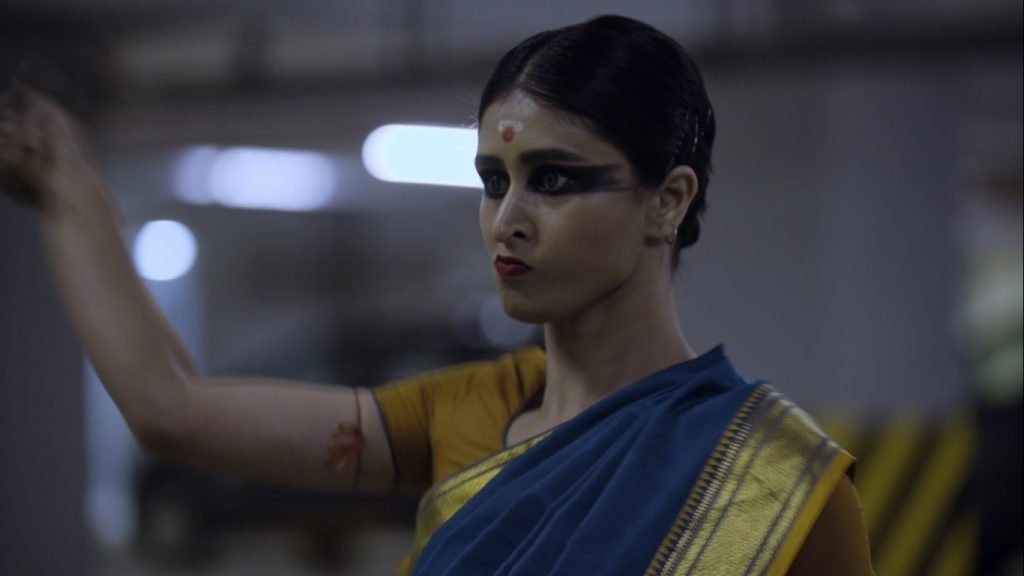Devi Aur Hero (2019): Before I begin writing about the film, I’d like to inform the readers that its graphics and language content may be uncomfortable and triggering since they deal with explicit mentions of sexual abuse, harassment, suicide, mental health, and violence. The review of the film inevitably seeks to discuss these aspects that form a major part of the film and can trigger a select readership.
Writer and director Aditya Kriplani’s third feature film, Devi Aur Hero, tells us the story of Kaali Ghosh (played by Chitrangada Satarupa) and Dr. Vikrant Saraswat (played by Vinay Sharma). Kaali is a young sex worker from Bengal currently engaged in the same profession in Mumbai. She is introduced in the film wearing a cheap blue wig and school uniform, understandably a role-play costume. She visits a psychiatrist, the above-mentioned Dr. Vikrant, to discuss her episodes of periodic blackouts and soon comes to know that she has Dissociative Identity Disorder (DID). She accommodates two other personalities within herself – a middle-aged woman, Mamta, and an old lady, Rukmani – who, we realize, are by-products of the long periods of sexual abuse and trauma she has faced since her childhood. On the other hand, Dr. Vikrant is clinically diagnosed with sex addiction; that is how his character is introduced to us in the opening scene of the film. He wishes to return to his regular psychiatry practice but is constantly worried that any association with the opposite gender may trigger his obsession. No brownie points for guessing this – While Kaali is trying to get better with Dr. Vikrant’s help, the latter is spiraling out of control in his lust for Kaali. Does Kaali and Dr. Vikrant establish a doctor-patient relationship where they mutually help each other through their conditions? Sadly, Kriplani’s take on trauma in this film is not only problematic but also disgraceful.
Dr. Vikrant’s room is caricatured to look like a haven for the sex-obsessed. His pillow and bedsheet are satin-white with female hands and fingers in red nail paint printed over them. The wall adjacent to his bed has posters of Gasper Noe films (how could there not be a reference to the 2015 French masterpiece on sensual pleasure, Love?) with the red of the wall paint almost oozing out to complement his sexual urges. Dr. Vikrant’s gaze at Kaali sexualizes her body from the nape of her neck to the forehead between her eyes. The camera appears to be licking Kaali’s skin, letting us observe the detailing of her metal jewelry or the shaved hairs around her lips with almost penetrating clarity. It is symbolic of the lustful male gaze that penetrates this movie from the beginning till the end, discomforting to sit through, especially as Dr. Vikrant is constantly churning Kaali’s features in his head to pleasure himself in more than one instance during its runtime. His obsessive behavior risks the doctor-patient confidentiality that should exist between him and Kaali.
Kriplani finds it fit to portray the same sexualized female body, which pulls him down the chasm of obsessive behavior, ultimately responsible for repelling him and pulling him out of his maniac obsession with sex. The reason for this repulsion is rooted in Dr. Vikrant’s regression towards physical impairment of the female form – a deeply problematic stance to advocate in the current century when there are more and more conversations around accommodating disability and terminal illnesses into the social norm. The film, after having bombarded the audience with this revelation, goes happily along to establish that Dr. Vikrant is successfully rid of his obsessive tendencies. How convenient for a male filmmaker to focus on its male protagonist on an affirming mental health journey at the cost of its female lead!
Kaali is a victim of the patriarchy, the filmmaker’s imagination, and popular ideas surrounding DID. Her accommodation is ever-changing, from Jr. Mitthal’s apartment to her own rooms in a colony, a slum, and a shanty by the roadside. She is reduced to an object of pity in the narrative of the film as well as to the audience. Does the film’s resolution implore the inner strengths of the female form, comparing her to Hindu mythological goddesses and the power to charge at the patriarchal power structure with violent intensity? Yes. Does it serve to problematize the film’s equivocal ending? Also, yes. Who is the hero if not Kaali, or if Kali is the hero, how did she become one? I am sorry, but I don’t understand it. The truth is that Kriplani is dealing with a sensitive topic and doesn’t have his safety gloves on. As a result, the rawness may be bold and daring for many but simultaneously immature and unthinking for a modern-day filmmaker.
Chitrangada is a fantastic actress, but she certainly deserved a better script. The film also has some lackluster editing, inconsistent pacing, and lousy scriptwriting; nothing to really drive home about. Devi Aur Hero (2019) should have known and could have done better if it could ultimately rid itself of the permeating male gaze. Alas!






![Trenque Lauquen [2022] ‘Venice’ Review: A Curious Mystery That Paints A Fragmented Portrait of a Woman](http://www.highonfilms.com/wp-content/uploads/2022/09/Trenque-Lauquen-2022-Venice-Review-768x432.jpeg)

![Coast [2022] Review – An uninspired tale about growing up in a sleepy town](http://www.highonfilms.com/wp-content/uploads/2022/06/Coast-Movie-Review-1-768x434.webp)

![Personal Shopper [2017]: An Arc Waiting to be Completed](http://www.highonfilms.com/wp-content/uploads/2017/04/personal-shopper-pic-768x433.jpg)